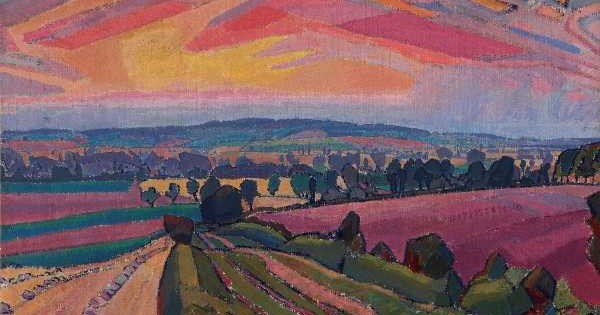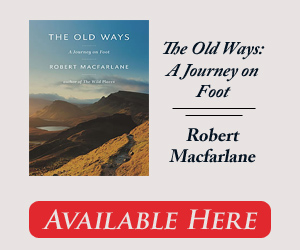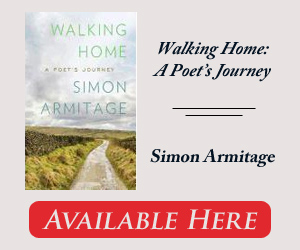
The Old Ways: A Journey on Foot, By Robert Macfarlane, Viking, 433 pp., $27.95
Walking Home: A Poet’s Journey, By Simon Armitage, Liveright, 224 pp., $24.95
I have a friend, an Englishman, who would think nothing at all of setting off from his parents’ house in rural Herefordshire and walking for many miles, upon nothing resembling asphalt or concrete, simply to get to a neighboring village or a pub. Such behavior, he tells me, is far from uncommon. It’s in the English DNA—this love of traversing long distances on foot, without sight of a paved road, for no reason more pressing than a pint. In America, we just don’t do such things: we’re a nation of drivers, not walkers. I remember flying into LAX years ago and needing to get from one terminal to another. When I asked a woman at an information desk for help, she told me to go outside and wait 15 minutes for a shuttle. “But how long would it take if I wanted to walk there?” I said. “Nobody walks to Terminal 4,” she said with barely concealed disgust. I decided to ignore her advice. Ten minutes later, I arrived at my destination.
The kinds of journeys undertaken by the English travel writer Robert Macfarlane—and described so beautifully in The Old Ways—would be possible in precious few parts of America. The old ways in question are sometimes remote, occasionally treacherous, usually forgotten paths “connecting place to place, leading over passes or round mountains, to church or chapel, river or sea.” These routes of chalk, peat, heather, and mud are located mainly in the United Kingdom, though Macfarlane does go abroad, to Tibet, Palestine, and Spain. And though he also does a bit of cross-country skiing and sailing, mostly he chooses to walk.
As Macfarlane wanders through worlds dating back to Neolithic and Mesolithic times, he encounters new ways of “feeling, being and knowing.” He is, among other things, an impeccable observer of the natural world, expert in all matters botanical and geological. “I passed through miniature cactus forests of samphire,” he writes, “and between torn chunks of ferroconcrete. The surface of the mud, a gritty curded paste, was intricately marked with the filigree of worm tracks and crab scrabbles.” Lines such as this, densely metaphorical, are at once musical and strange, and they seem to describe not a familiar world, but an alien one.
For Macfarlane, walking is a form of pilgrimage, a sacred activity very different from mere recreation. It can also be an act of political protest or resistance, as in Palestine or Tibet, where straying into forbidden zones can provoke a confrontation with an unsympathetic military patrol. The larger issue, even in places governed by less volatile politics, is one of access. Macfarlane can wander across vast stretches of the United Kingdom because of the British right to roam, which allows everyone access to certain kinds of uncultivated land, terrain that might once have been the province of the landed gentry. The principal distinction between the United Kingdom and the United States as walking nations, then, goes well beyond our predilection for the automobile. Here, property rights trump all, and ambling 10 miles in the countryside brings the considerable risk that you’ll encounter an angry landowner with a shotgun. I think this is why we tend to be such avid hikers (as opposed to strollers, meanderers, or saunterers). Our land-use laws confine us to state parks and forests—demarcated and set aside for recreation—where we gear up with backpacks and walking sticks and backcountry boots. This wasn’t always the case. In his 1862 essay “Walking,” published in The Atlantic Monthly, Henry David Thoreau described how he could “walk ten, fifteen, twenty, any number of miles, commencing at my own door, without going by any house, without crossing a road except where the fox and the mink do.” Yet he also prophetically warned of a time when we would not enjoy such freedoms:
At present, in this vicinity, the best part of the land is not private property; the landscape is not owned, and the walker enjoys comparative freedom. But possibly the day will come when it will be partitioned off into so-called pleasure-grounds, in which a few will take a narrow and exclusive pleasure only,—when fences shall be multiplied, and man-traps and other engines invented to confine men to the public road, and walking over the surface of God’s earth shall be construed to mean trespassing on some gentleman’s grounds.
Many of the footpaths Macfarlane takes—for example, the shepherds’ roads of the Outer Hebrides—are slowly being forgotten, “disappearing both from memory and from the land.” Walking, then, becomes an act of preservation. We make tracks with our footfall, thereby keeping a trail alive. But by observing and remembering what we encounter along the way, we can also preserve a place in memory and imagination. “We tend to think of landscapes as affecting us most strongly when we are in them or on them,” Macfarlane writes, “when they offer us the primary sensations of touch and sight. But there are also the landscapes we bear with us in absentia … and such places—retreated to most often when we are most remote from them—are among the most important landscapes we possess.”
The focused sort of journey that Simon Armitage embarks on in Walking Home shares little with Macfarlane’s leisurely meandering. Armitage’s trip, along the 260-mile Pennine Way, connecting southern Scotland with the English Midlands, is more akin to navigating the Appalachian Trail: a specific challenge to be endured and overcome. And though it’s only a fraction as long as its American counterpart, the Pennine Way is arguably the toughest hike of its kind in the United Kingdom, featuring “wide and undulating expanses of high altitude, treeless hillsides, often boggy, usually with very poor or ‘peat’ soil, incapable, on the face of it, of sustaining anything but the hardiest of grasses or the most adaptive of species.”
Armitage, a celebrated poet and translator (read his masterly rendition of Sir Gawain and the Green Knight), is a Yorkshireman, and he knows “these endless, empty and ungoverned places” well. But for someone who spends most of his days holed up in an office, the prospect of 40 grueling days out of doors doesn’t seem altogether pleasant. It was to prove that he hadn’t “become a complete lotus-eating aesthete” that Armitage set forth in the summer of 2010, taking with him no money, but playing the part of a “modern-day troubadour, giving poetry readings at every stop, bartering and trading my way down country, offering only poetry as payment.”
Day after day, mile upon mile, Armitage’s blistered feet carry him along. The poetry readings, in village halls, pubs, or homes, sometimes go well, but often the audiences are indifferent or unenthusiastic, though they do provide more than enough money for Armitage to continue his journey. All in all, it’s a relentless slog in the face of an ever-punishing wind and frequent, saturating rain. “Hey, ho, the wind and the rain,” Shakespeare wrote—he might as well have been describing a summer’s day in the north of England.

Yet Armitage tackles all of this in the best of spirits. He’s the everyman out to do the impossible, always genial and companionable, full of humor and self-deprecation. If Macfarlane’s prose, beautiful and elegant as it is, sounds mainly on one sublime tonal register, Armitage’s style assumes many moods, moving from the casual to the elevated, from the lyrical to the mock-heroic. And not surprisingly for a poet, he gives us the occasional startling image: “I’d shinned up to the top of a high dry-stone wall, and was looking back down towards the lake, the surface of which was completely unbroken, lying there like spilt mercury under the brightening sky.”
It’s easy to get lost along the Pennine Way, with its mist-shrouded moorlands disorienting the unsuspecting walker. And indeed, Armitage does lose his way. But amid a “silvery, swirling mass” of mist and cloud, he experiences something more harrowing than the usual panic or fear; he is overcome by a profound sense of melancholy, of “losing any sense of who I am, as if the mist is bringing about an evaporation of identity, all the certainties of the self leaching away into the cloud.” Signposts on the trail provide reassurance. His map is indispensable. “A sheepfold,” he writes, “a disused quarry, even a thin wire fence: tuning into this fine-scale cartography takes time and concentration, but being able to put a finger on the map and say with absolute confidence I AM HERE makes the air smell sweeter and the sandwiches taste fresher.”
Macfarlane seems happiest in true wilderness, far from the modern world, where a sheepfold or thin wire fence does nothing so much as help him read the land, imagine its history, contemplate his place in the long line of people who have ventured into this terrain before him. Armitage just wants to get to his night’s destination, preferably guided by his GPS. Standing among the intimidating mountains, under skies threatening to open up, “the only person in a vast and empty landscape,” he feels “utterly insignificant and intensely scrutinised.” So when he comes to a shelter, and “[s]omeone else appears from nowhere, a woman walking a dog, then a couple of hikers,” and when “suddenly all four bays are taken,” and everyone gets “on with our lunches and snacks and mobile-phone conversations in the privacy of our own right angles”—we sense that he is not annoyed, his sojourn interrupted, but deeply relieved.
As with Macfarlane, however—who is attuned to how the road “pressed into the soles of [his] feet” and who “for days after the walk” feels “a memory of that pressure and pattern”—these 40 days on foot have established in Armitage a surging rhythm that he cannot easily forget. “That’s what I do now: I lace up my boots and head into the hills, then do the same again the next day, and the day after that, and the day after that. Where do I live at the moment? On the move. It’s a routine, a rhythm, the norm. I walk therefore I am. And now that I’ve got used to it, I feel too lazy to stop.”
Everything around us is in constant flux and motion—we just have to get out there to realize it, to step amid the rhythms of the wider world. Walking keeps us alive, keeps us aware, presents us with a connection to our surroundings that ultimately prevents us from degrading them. It’s just harder to do in some places than in others.


